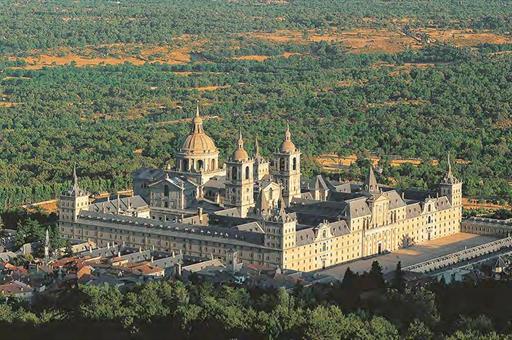Contents
From prehistoric times to the discovery of America
The Early Settlers
Based on the findings at Atapuerca (Burgos province), estimated to be around 800,000 years old, the presence of hominids on the Iberian Peninsula dates back to the Lower Palaeolithic period. Experts are still debating the origin of these early settlers, who may have entered the peninsula directly from Africa via the Straits of Gibraltar, but more likely arrived by crossing over the Pyrenees. In any case, the remains of utensils and works of art found on the peninsula are certainly from this period, corresponding to the same hunter-gatherer cultures that existed in other parts of Europe.
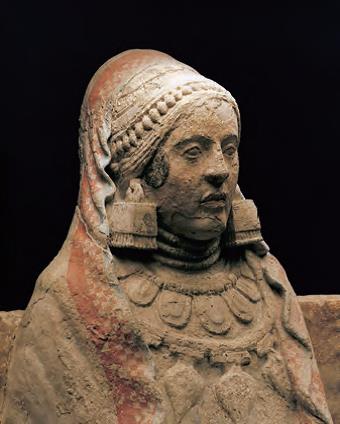 Dame of Baza (Museo Arqueológico Nacional)Moreover, the Iberian Peninsula constituted the western boundary of a process of cultural dissemination that began in on the eastern shore of the Mediterranean around the fifth millennium B.C. Known as the Neolithic Revolution, this process consisted of the transition from a collector economy to a producer economy based on agriculture and stockbreeding. Another period in the history of the peninsula began around 5000 or 4000 B.C. and lasted until the 16th century A.D., which was characterised by the dominant role of the Mediterranean basin and civilisations.
Dame of Baza (Museo Arqueológico Nacional)Moreover, the Iberian Peninsula constituted the western boundary of a process of cultural dissemination that began in on the eastern shore of the Mediterranean around the fifth millennium B.C. Known as the Neolithic Revolution, this process consisted of the transition from a collector economy to a producer economy based on agriculture and stockbreeding. Another period in the history of the peninsula began around 5000 or 4000 B.C. and lasted until the 16th century A.D., which was characterised by the dominant role of the Mediterranean basin and civilisations.
From approximately 1100 B.C. until the middle of the 3rd century B.C., commercial and cultural contact with the Mediterranean civilisations was articulated by the Phoenicians (whose territories extended from the Algarve on the peninsula's South Atlantic coast to Iberia's Mediterranean shores in the east) and the Greeks (whose influence stretched from the estuary of the Ebro River to the Gulf of Roses on the north-eastern coast of Spain). At the end of this period, both civilisations were displaced by the Romans and Carthaginians respectively.
Hence, between the 12th and 4th centuries B.C., substantial differences emerged between the Iberia that extended from the Mediterranean in the northeast to the Atlantic in the south, and the Iberia of the peninsular inland region. The latter territory was inhabited by various tribes, some of them Celts. With a relatively primitive social organisation, these peoples engaged in migratory herding, which consisted of alternating the grazing pastures in the northern uplands that they used in the summer with those of the southern part of the central plateau, or Meseta, used in the winter. Shepherds and sheep, the conquerors of grazing lands, played a key role in the geo-history of the Iberian Peninsula.
By contrast, in the 4th century B.C. the peoples of the coastal region generically known as Iberians had already formed a homogenous group of city- states (Tartessus, the biblical Tarshish or perhaps the legendary submerged Atlantis) influenced by the more developed urban, trading, farming and mining centres of the Eastern Mediterranean. The earliest written records about the peninsula date from this period. Hispania, the name the Romans gave to the peninsula, is allegedly a Semitic word derived from Hispalis (Seville).
The Persistent Traces of the Roman Presence
The Roman presence on the peninsula basically followed the same pattern as the Greek commercial bases, but unlike the Greeks, Rome's introduction to Iberia was the result of a power struggle with Carthage to gain control of the Western Mediterranean during the 2nd century B.C. In any case, it was at this point that the Iberian Peninsula as a geographic unit entered the arena of international politics and, by virtue of its privileged location between the Atlantic and the Mediterranean and its rich agricultural and mineral resources in the south, became a much coveted strategic objective.
The Roman invasion and eventual conquest of the peninsula took place over the long period between 218 and 19 B.C. The Romans were alarmed by the Carthaginian expansion to the northeast; like Napoleon centuries later, they believed that the Ebro River delineated a natural boundary with Gaul, which was then a Roman province.
This conflict of interests led to the Second Punic War. While Hannibal was making his legendary journey across the Alps, the Roman legions were attacking his Spanish base at Carthago Nova (present-day Cartagena), with its seaport and mines. Hannibal's defeat by Publius Cornelius Scipio (209 B.C.) not only marked the beginning of the end for his army in Italy; it was also the beginning of the Roman conquest of Spain.
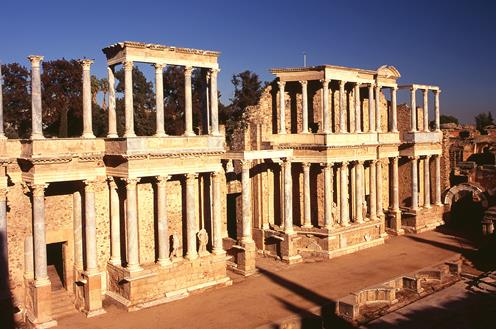 Roman theatre of Mérida (Turespaña)The Romans did not just want to replace the Carthaginians, but to extend their dominion to the rest of the peninsula. However, these plans met with considerable resistance, particularly in the interior.
Roman theatre of Mérida (Turespaña)The Romans did not just want to replace the Carthaginians, but to extend their dominion to the rest of the peninsula. However, these plans met with considerable resistance, particularly in the interior.
Of the numerous confrontations that took place throughout the Roman conquest of the inland region of Hispania, the most famous was the so- called Celtiberian-Lusitanian War, which lasted for twenty years (154-134 B.C.). The war tactics of the Lusitanian chief Viriathus and the legendary, although unsubstantiated, collective suicide of the people of Numantia under siege by the Romans were much celebrated by Latin historians.
The Roman presence in Hispania lasted seven hundred years, during which time the basic boundaries of the peninsula in relation to other European countries were established. The interior divisions drawn up by the Romans seem curiously prophetic: Lusitania, Tarraconensis and Baetica. But the Romans bequeathed more than just a territorial structure; they also left institutions such as the family unit, language, religion, law and the concept of the municipality, and their assimilation situated the peninsula firmly in the Greco-Latin and later the Judaeo-Christian world.
The Romans mainly settled along the coasts and rivers, bequeathing the enduring importance of cities such as Tarragona, Cartagena, Lisbon and particularly Mérida. Meanwhile, the vast array of public works such as roads, bridges, aqueducts, temples arches, theatres, amphitheatres and circuses clearly reflects the geographical distribution of Roman settlements on the peninsula. However, at the beginning of the 5th century A.D. the map of Roman colonisation began to change dramatically when a variety of Germanic peoples marched into the peninsula and settled in the interior, in the case of the Visigoths, and in the west, in the case of the Suebi. At the same time, certain phenomena had been gaining momentum since the 3rd century A.D. such as the reduction of the urban population, the construction of fortifications around cities, the extension of latifundismo (the division of the land into large estates), the lack of safety in rural areas and the weakening of the state as an institution. On the other hand, local oligarchies were becoming more powerful as they offered safety in return for loyalty. A major event of this period was the beginning of the Christian conquest of Hispania, although its exact origins are still unknown. St. Paul was probably present in Hispania between 62 and 63 A.D., and Prudentius' narrative of the 3rd century persecution of Christianity mentions dioceses and martyrs. Following Constantine's Edict of Milan, which granted religious freedom, the first Council of the Spanish Church was held in 314 A.D.
The Visigoth Kingdom: First Attempt at Peninsular Unity
By the 5th century the Visigoths were already a Romanised people who saw themselves as the perpetuators of the extinct imperial power. Around the mid 500s, the pressure exerted by the Suebi in the west (Galicia), the Cantabrian- Pyrenean shepherds in the north, and the Byzantines in the south (Baetica) on three different fronts led them to establish their capital in Toledo at the centre of the peninsula.
Integration between Visigoths and Hispano-Romans was both rapid and successful. It was also greatly facilitated by King Reccared's conversion to the Catholic faith at the 3rd Council of Toledo (589), which enabled the Church to acquire a predominant and fiscal role in politics through the celebration of a series of Councils of Toledo and the adoption of relatively similar social structures, contained in the Liber Judiciorum promulgated by Recceswinth that basically unifi ed Visigothic and Hispano-Roman law. Both cultures boasted a landed aristocracy and an ecclesiastical aristocracy, and both institutions favoured the autonomy of the nobility at the expense of royal power.
Muslim Spain: Cradle of a Flourishing Culture
It was precisely one of the ostracised noble clans, the Witiza family, which brought about the collapse of the Visigothic state at the beginning of the 8th century by appealing for help to the Arabic and Berber troops on the other side of the Straits of Gibraltar. In fact, the degree of disintegration within the Visigothic state apparatus enabled the Muslims to secure isolated pacts with the semi-independent aristocracy hostile to the Crown.
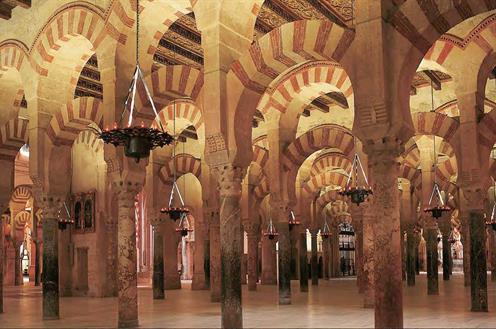 Córdoba Mosque (Turespaña)By the mid-8th century, the Muslims had consolidated their occupation of the land, and in Cordoba the Umayyad prince Abd al-Rahman proclaimed himself emir of a new state, independent of Damascus. During the first third of the 10th century, a member of the Umayyad dynasty in Hispania, Abd al-Rahman III, restored and expanded the state of Al-Andalus and became the first Spanish caliph.
Córdoba Mosque (Turespaña)By the mid-8th century, the Muslims had consolidated their occupation of the land, and in Cordoba the Umayyad prince Abd al-Rahman proclaimed himself emir of a new state, independent of Damascus. During the first third of the 10th century, a member of the Umayyad dynasty in Hispania, Abd al-Rahman III, restored and expanded the state of Al-Andalus and became the first Spanish caliph.
The proclamation of the caliphate had a dual purpose. In the interior, the Umayyads were keen to reinforce the peninsular state. In the outlying territories, their quest was to consolidate the commercial routes in the Mediterranean that would guarantee economic relations with the eastern basin (Byzantium) as well as the supply of gold. Melilla was occupied in 927 and by the middle of the same century the Umayyad Caliphate controlled the triangle between Algeria, Sijilmasa and the Atlantic. The small Christian enclaves in the north of the peninsula became modest fiefdoms of the caliph, whose superiority and arbitration they recognised.
The foundations of Muslim Spain's hegemony rested on considerable economic power derived from substantial trade, a highly developed crafts industry and farming methods that were much more efficient than those employed in the rest of Europe.
The Caliphate of Cordoba was the first urban and commercial economy to flourish in Europe since the fall of the Roman Empire. Moreover, its capital and main city, Cordoba, had a population of approximately 100,000, which made it the largest urban centre in Europe at the time.
Muslim Spain produced a flourishing culture, especially following the accession of the caliph Al-Hakam II (961 976), who is attributed with creating a library of several hundred thousand volumes - an inconceivable feat in Europe at the time. The most characteristic trait of this culture was its swift re-adoption of classical philosophy, most notably by Ibn Masarra, Abentofain, Averroes and the Jewish philosopher Maimonides. But above all, Hispano-Muslim scholars were noted for their contributions to the fields of medicine, mathematics and astronomy.
The fragmentation of the Caliphate of Cordoba occurred at the end of the first decade of the 11th century and was brought about by the intense military aggressions perpetrated by its last leaders, combined with asphyxiating fiscal pressure. The successors of the unitary caliphate were known as taifas or petty kingdoms, and the word has passed into the Spanish language as a synonym of the ruin that generated the fragmentation and disunity of the peninsula. As a result of this gradual weakening of the state, by the mid-13th century Muslim Spain had been reduced to the Nasrid kingdom of Granada.
From the Early Christian Resistance to the Reconquest of Spain
The first Christian uprising occurred in the first third of the 8th century in Covadonga, located in the mountains of Asturias.
However, this early Christian resistance was more a question of survival than a deliberate offensive campaign or "reconquest." In the 10th century, Alfonso III advanced from Oviedo to Leon, en route to the Duero River Valley. On the Meseta, this expansion led to the creation of the county and then the kingdom of Castile, which later united with the kingdom of Leon under the reign of Ferdinand III in 1230. Meanwhile, in 1143 the Atlantic flank of the peninsula became the kingdom of Portugal.
During the 12th and 13th centuries, the four main Christian kingdoms of the Iberian Peninsula were formed: Portugal, Castile-Leon, Navarre and Aragon- Catalonia.
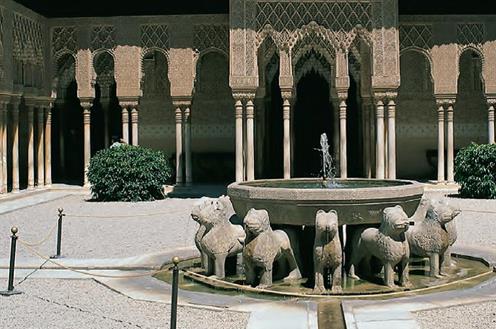 Court of the Lions, La Alhambra (Turespaña)From a continental perspective, the Reconquest took place within the context of the growth and offensive expansion that characterised the history of the western segment of Europe between the 10th and 13th centuries against Hungarian, Slavic and Muslim invaders. The result of these dynamics was the creation of the area we now call Western Europe around 1300 A.D.
Court of the Lions, La Alhambra (Turespaña)From a continental perspective, the Reconquest took place within the context of the growth and offensive expansion that characterised the history of the western segment of Europe between the 10th and 13th centuries against Hungarian, Slavic and Muslim invaders. The result of these dynamics was the creation of the area we now call Western Europe around 1300 A.D.
By the final third of the 13th century the Muslim presence had been reduced to the Muslim presence had been reduced to the Nasrid kingdom of Granada until 2 January 1492. The end of the Reconquest - or, in Roman- Visigothic terminology, the recovery of Hispania - had a profound impact on Christian Europe, being regarded as compensation for the fall of Constantinople to the Turks.
Given that the Reconquest lasted so long, there were several periods of co-existence and even, at certain times in the 12th century, a type of frontier society. In any case, the Christian monarchs conquered through colonisation, offering land to anyone who promised to occupy, cultivate and defend it. This gave rise to transfers and migrations from the north of the Iberian Peninsula and Europe, a rare phenomenon in other latitudes at the time. Those colonisers gradually formed a peasant society that was comparatively freer than its contemporaries in other parts of Europe, where subjugation to the feudal lords was much greater.
Between the 9th and 11th centuries, these semi-free peasants were grouped into towns governed by elected councils to which the monarchs granted special charters (fueros) based on certain exemptions and privileges. Subsequently, in the 12th century, these burghers sat down with the other two branches of society - the nobility and the clergy - in assemblies known as Cortes, where they discussed and voted on matters pertaining to taxes.
The Catholic Monarchs: Peninsular Unity and the Imperial Enterprise of the Spanish Renaissance
The quest for unity did not end with the last military victory of 1492 and the conquest of Granada, but continued - in its ambition for religious, ethnic and cultural uniformity - with the expulsion that same year of the Jews who refused to convert to Catholicism and then of the Moriscos, or Moorish converts. The difficult situation in which the Jews found themselves was not confined exclusively to Spain. Since the Council of Letran in 1215, they had unfortunately suffered a similar if not harsher fate in the rest of Europe. Until 1492, Christian territory in Spain had been a melting pot of Jewish, Muslim and Christian cultures, most famously giving rise to the so-called disputas or debates between scholars of the three cultures united in a movement sponsored by King Alfonso X and known as the Toledo Translation School. The work produced by this school enriched European culture with the science of the Greeks and the achievements of the Arabs.
Expansion of the calibre described above undoubtedly created a frontier economy with the acquisition of vast spaces. Since the 13th century the Hispanic kingdoms were based on rapidly growing societies, the dynamics of which were clearly reflected in the economic and political boom experienced by the kingdom of Aragon with the conquest of Sardinia, Sicily and Naples in the Mediterranean.
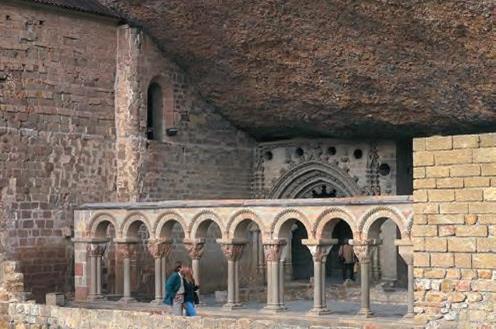 San Juan de la Peña Monastery (Turespaña)Thanks to a combination of economic interests and a seafaring vocation, Castile was able to occupy a vanguard position in the quest for and consolidation of new commercial routes with the East. In this race, the Castilians found an extremely active competitor in another Iberian state-Portugal. A first attempt at resolving the rivalry between the two kingdoms for the control of the maritime eastern trade routes was the Treaty of Alcaçovas. Signed in 1479, this agreement enabled Castile to maintain the Canary Islands in return for renouncing all eastern voyages around the African coast, which was assigned to Portugal. Such an unfair division can only be explained by the fact that the treaty also addressed an age-old issue of the Iberian states, namely, the unity of the peninsula.
San Juan de la Peña Monastery (Turespaña)Thanks to a combination of economic interests and a seafaring vocation, Castile was able to occupy a vanguard position in the quest for and consolidation of new commercial routes with the East. In this race, the Castilians found an extremely active competitor in another Iberian state-Portugal. A first attempt at resolving the rivalry between the two kingdoms for the control of the maritime eastern trade routes was the Treaty of Alcaçovas. Signed in 1479, this agreement enabled Castile to maintain the Canary Islands in return for renouncing all eastern voyages around the African coast, which was assigned to Portugal. Such an unfair division can only be explained by the fact that the treaty also addressed an age-old issue of the Iberian states, namely, the unity of the peninsula.
Although the incorporation of Navarre in 1512 improved peninsular unity, the cycle of unification was really completed with the capture of Granada in 1492. That same year, Nebrija published the first grammar of a popular language - Castilian - and a Spanish fleet reached the coasts of America.
The legendary aura surrounding Ferdinand and Isabella, the Catholic Monarchs, has hindered the task of providing an adequate assessment of their context and a sober evaluation of their work.
Internally, they invested all their efforts in reinforcing the state apparatus and the authority of the Crown, seeking support in the existing legal and administrative institutions and creating new ones, often inspired by those of other European countries. Such was the case, for example, of the Tribunal of the Inquisition. Introduced at a later date in Spain than elsewhere, this court not only served religious purposes but was also an instrument used by monarchs to reinforce the authority of the state.
In 1492 the Spanish monarchy represented one of the earliest modern states in Renaissance Europe. Its outward expansion across the Atlantic (the Americas and Flanders) and the Mediterranean (Italy) was based precisely on this. Indeed, Spain's foreign policy at the time was orchestrated by the creation of a permanent state staffed by civil servants and diplomats, with a unitary but flexible and confederate concept of the monarchy.
Although Castile had lost its African routes to Portugal, its possession of the Canary Islands provided it with an excellent springboard for alternative routes. This is precisely what Christopher Columbus offered the state, which was clearly in need of such an offer, although it had prepared for and become accustomed to enterprises of this nature. By 1492 the united Spain boasted powerful war machinery, a solid economy, an international presence, experience at sea and in exploring new commercial routes, and considerable scientific and technical expertise: mathematicians, geographers, astronomers and shipbuilders, forged in the melting pot of the three cultures.
From the discovery of America to the 20th century
The Conquest of America: The New Frontier of the Largest Western Empire
By the mid-16th century, the main viceroyalties had been established and settled: Mexico on the Atlantic flank and Peru in the South American Pacific.
On 6 September 1522, Juan Sebastián Elcano returned to the peninsula as a survivor of the first circumnavigation of the world initiated by Magellan, thereby providing Spain with a route to the East. Thereafter, Havana- Veracruz (the Tierra Firme fleet) in the Atlantic and Acapulco-El Callao-Philippines (the China ship) in the Pacific, together with control of the Western Mediterranean - under eternal threat from the Turks - became the vital arteries of the Spanish Empire's overseas territories. The convoys of Spanish galleons maintained these routes open despite attacks from marauding English and Dutch ships until the decisive Battle of Trafalgar in 1805.
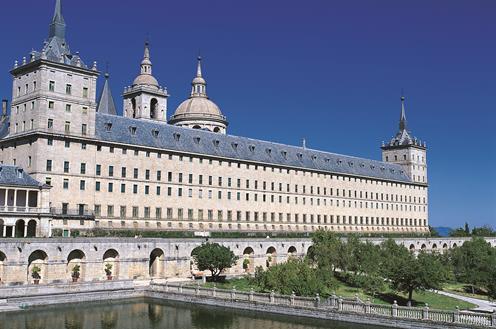 San Lorenzo de El Escorial Monastery (Turespaña)In many respects the conquest of America was similar to the peninsular expansion that preceded it. In both cases, confrontations were a last resort, used only after intense attempts to avoid them. The Spanish sought allies in the tribes they subjugated and in discontented leaders; they agreed to capitulations in exchange for privileges; they distributed the new lands among Spanish colonists; and they reorganised the indigenous settlements.
San Lorenzo de El Escorial Monastery (Turespaña)In many respects the conquest of America was similar to the peninsular expansion that preceded it. In both cases, confrontations were a last resort, used only after intense attempts to avoid them. The Spanish sought allies in the tribes they subjugated and in discontented leaders; they agreed to capitulations in exchange for privileges; they distributed the new lands among Spanish colonists; and they reorganised the indigenous settlements.
In Italy the Spanish monarchy adopted the tradition of engaging in confrontations with France and alliances with England. The Battle of Pavia in 1521, which resulted in the capture of King Francis I of France by the Spanish infantry regiments, consolidated Spain's superiority until the mid-17th century.
Eventually, in their quest to further Spain's diplomatic and commercial relations with the Netherlands, Ferdinand and Isabella joined the Spanish Crown to the Duchy of Burgundy. The fabulous legacy embodied in the Flemish Prince Charles, grandson of the Emperor Maximilian and the Catholic Monarchs, was to condition Spanish and European politics until the 18th century. The solution adopted by the Spanish Hapsburgs to manage this enormous legacy was to establish an all-encompassing, flexible monarchy, consisting of a constellation of kingdoms and domains united in a vast confederation around a single Crown. There would have been no unity without the figure of the king, since each kingdom maintained its own institutions, language, laws, and even its own borders.
The Carolingian Empire was therefore a conglomerate of territories randomly united under a common sovereign. The first consequence to arise from this was the complete absence of any attempt to create an institutional organisation common to the whole empire. Similarly, the second consequence was that no attempt was made to secure any type of political or economic cooperation between the various territories, which would have helped consolidate the idea of an empire - that is, the participation of all parties in a shared enterprise. The most notable achievement of Spain under the Hapsburgs was its ability to retain control over its vast territories spread around the world. No other state in the 16th and 17th centuries was faced with such an enormous administration problem. Spain had to explore, colonise and govern a new world.
The Spanish Empire and its "Black Legend"
This acceptance of differences by the Spanish Hapsburgs encompassed all domains except for one: religion. They strove to create a universal empire founded on the Madrid-Brussels-Vienna triangle, which did not sit well with the emerging nationalist states and was even less palatable to the individualist mindset of the Reformation. These two ingredients - nationalism and Protestantism - met head on in the Dutch uprising against Philip II, who had succeeded the Emperor Charles in the Duchy of Burgundy and on the throne of the Spanish kingdoms in 1556.
The conquest of America was an attempt to annex the territory and subjugate the population. Just as the Roman Empire had done, language, religion, laws, administration and crossbreeding provided the vehicles for the Hispanicisation of America, all of which guided the continent firmly into the western fold. Several Spaniards, including Bartolomé de las Casas, spoke out against the abuses of the conquerors, which gave rise to the so-called "Black Legend" of Spanish cruelty in the Americas.
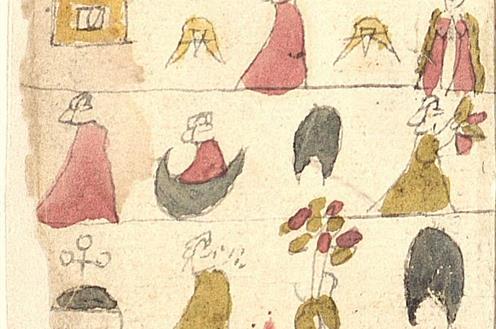 Catechism in indigenous American hieroglyphs (Archivo Histórico Nacional)The issue became the subject of intense political debate; the so-called "Indian question" consisted of doubts regarding Spain's right of conquest, which was eventually justified as an evangelising mission. Against such a background it is hardly surprising that it was the Spanish, through Francisco de Vitoria, who first advocated the concept of international law.
Catechism in indigenous American hieroglyphs (Archivo Histórico Nacional)The issue became the subject of intense political debate; the so-called "Indian question" consisted of doubts regarding Spain's right of conquest, which was eventually justified as an evangelising mission. Against such a background it is hardly surprising that it was the Spanish, through Francisco de Vitoria, who first advocated the concept of international law.
Fiscal Crisis, Centralism and the Decline of the Spanish Empire
The state that had gradually been forged, first by the Catholic Monarchs and later by Philip II, was the prototype of the modern absolutist state. The Spanish Empire invented an administrative apparatus that was highly complex for the time, based on a system that put security before all else and attained enormous prestige. The state grew considerably, assuming responsibilities and duties that were too much for the increasingly impoverished agrarian society of the ancien régime to bear. But rather than reducing the size of the state and eradicating duties, the imperialists chose to asphyxiate society. The breakdown of the system became evident in 1640 with the rebellion of Catalonia and the separation of Portugal.
The decline of the Spanish Empire, brought about by fiscal exhaustion, coincided with a gradual disintegration of the confederated system, which was subjected to centralist practices. In addition to these two factors, Spain was also the victim of its own success: The incorporation of the Americas and the expansion of transoceanic navigation shifted the European geo-economic axis from the Mediterranean to the Atlantic, and more precisely to the basins of the Thames, Rhine, Seine and Scheldt, relegating Spain to a peripheral position.
However, peripheral is not to be confused with marginal, and Spain maintained its status as a great power and a key player in Europe with the Americas and Naples still under its control. Following the Treaty of the Pyrenees in 1659, it had ceded its hegemonic role to the French kingdom of Louis XIV, which made the "Sun King" into the arbiter of European politics and France into the model for what was soon to become the reformed government of 17th century enlightened despotism.
Charles II, the last of the Spanish Hapsburgs, was childless and bequeathed his inheritance to a grandson of his sister Maria Theresa and Louis XIV of France, Philip of Anjou. Crowned King of Spain and the Indies in 1701, Philip V inaugurated the dynasty of the Spanish Bourbons. His reign prolonged the Enlightenment in Spain, a period of foreign policy equilibrium, reform and internal progress.
Spain under the House of Bourbon and the Enlightenment
The rest of Europe viewed the will of Charles II with suspicion. This led to the Spanish War of Succession (1705-1713), with the Treaty of Utrecht signifying victory for Philip V.
However, at Utrecht Philip V and his successors were obliged to renounce their Flemish inheritance. The official renunciation of Flanders constituted the end of the old universalising conception of the Spanish-Austrian monarchy and the beginning of the nationalisation of Spanish politics.
Balance and peace in Europe became the two goals pursued by Spain throughout the 18th century. However, this ambition was thwarted by England's commercial and colonial expansion on the one hand, and by the rivalry between England and France on the other. Spain's desire for neutrality and peace was best embodied by Ferdinand VI (1746-1759).
During the reign of Charles III (1759-1788), the politics articulated by Prime Minister Floridablanca managed to keep Spain out of military conflicts, despite a tentative intervention in the American War of Independence. Charles III's legacy was a country at peace and well on the road to progress, and it took a long time for the French Revolution of 1789 to derail this peaceful, non- interventionist policy.
The germination of a Spanish nationality in foreign policy was accompanied by a parallel phenomenon in the country's domestic politics; indeed, the two developments were closely related. During the War of Succession, the Kingdom of Aragon had backed the Austrian candidate, a choice that presented the victorious Philip V with a perfect excuse for embarking on what was to become a chain of profound reforms in the structure of the state and the Spanish government.
The Decree of Nueva Planta (or new approach, which aimed to reorganise the country) was to internal politics what the Treaty of Utrecht was to foreign policy, as it implied the extension of the Castilian administrative structure to the Kingdom of Aragon and the abolition of Aragon's fueros or special charters, thus bringing the confederate monarchy of the Hapsburgs to an end. This marked the first step on the road to centralisation, which was completed a century and a half later by liberal governments.
The disproportionate and chronic deficit of the 17th century was reduced and a tendency towards budgetary balance recovered, which was only broken at the end of the 18th century. The country's improved fi nancial management was brought about by another two factors: less was spent on foreign ventures and more taxes were collected, not only as a result of a more efficient fiscal system but also because Spanish society was more prosperous.
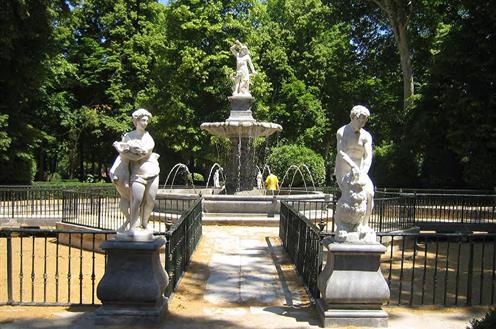 Aranjuez Royal Palace (Turespaña)The Bourbons were exemplary figures of the reformism of Europe during the Enlightenment. They sought progress and efficient organisation for the country according to the theories of their time, which were influenced by mercantilist ideas, interventionist methods and, to a lesser degree, liberal impulses.
Aranjuez Royal Palace (Turespaña)The Bourbons were exemplary figures of the reformism of Europe during the Enlightenment. They sought progress and efficient organisation for the country according to the theories of their time, which were influenced by mercantilist ideas, interventionist methods and, to a lesser degree, liberal impulses.
A major step forward was made with the removal of all obstacles to trade and industry. The elimination of "dry ports," which economically isolated certain areas from others, and the opening of all the ports in the kingdom provided a major boost to the trade conducted not only between these national ports but also with foreign ports, so that by the end of the century 75% of the trade with the Americas had been recovered. Similarly, the Catalonian cotton industry began to take off; this growth was so pronounced that, prior to the French invasion of 1808, it represented two-thirds of the British cotton industry. The progressive liberalisation of farm prices and the limitation of the privileges of the Mesta (a powerful association of sheep ranchers in the medieval Kingdom of Castile) contributed to provide a greater quantity of land for cultivation and an increase in agricultural production.
However, in Spain as in the rest of Europe still governed by the social order of the ancient régime, the land problem consisted of vast expanses purloined from the market and placed in the hands of either the Church - which owned 15% of the cultivable area - the municipal councils or the nobility. The confiscation policy initiated - albeit timidly - by the enlightened governments formed part of a general policy aimed at reducing tax and other exemptions, special privileges, judicial and territorial domains, and even the ecclesiastic and noble populations (the former still represented 3% of the total population, while in the latter case the number of gentry fell from 700,000 in 1763 to 400,000 in 1787).
The Bourbons also did away with a large proportion of the motley administrative apparatus inherited from the Hapsburgs and reduced the Councils. They promoted the creation of Secretarías (Ministries) and direct dealings with the king as part of a plan intended to marginalise the upper nobility from, as Louis XIV of France put it, "anything that could give them part of the government". The Bourbons recruited their senior civil servants from among the local and enlightened lower nobility, giving rise to a new social category - an ambitious middle-class nobility eager for advancement at the service of the state.
These civil servants were people of their time, enlightened in their thinking and convinced of their reforming mission, alert to the ideas of the period, often with foreign friends and a command of other languages. For example, Floridablanca was a friend of Benjamin Franklin and kept up a correspondence with Voltaire. In his Informe sobre la Ley Agraria (Report on the Agrarian Law), Jovellanos demonstrated his knowledge of the recent reforms introduced by Adam Smith, and he also wrote frequently to Lord Holland. The paradox lay in the fact that neither of these two figures enjoyed a reputation among their fellow countrymen, although at least they did not suffer the sad fate of Esquilache, whose reforms met with such widespread opposition that he had to go into exile.
The Napoleonic Invasion and the War of Independence
The Treaty of Fontainebleau (1807) permitted the French army of Marshal Junot to cross the Pyrenees and advance towards Portugal, and although the French entered Lisbon they did not leave Spain.
The crisis of the ancien régime that paved the way for the Napoleonic invasion was also a dynastic crisis that severely undermined the enormous prestige and authority of an ancient Crown. When Charles IV abdicated in favour of his son, the monarchy was irreparably damaged.
The political regime that the Bonapartes attempted to unify was laid out in the Statute of Bayonne, signed on 8 July 1808. Although this document is tremendously important from a historical standpoint, it never had any legal or practical significance because it was never enacted. It was, however, the first constitutional text to appear in Spain.
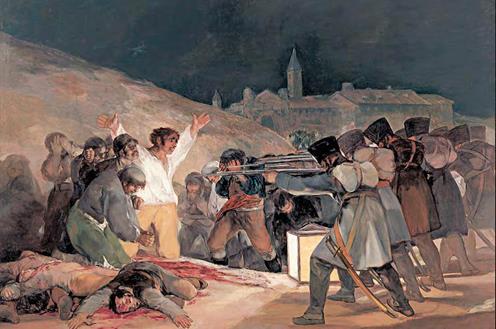 "The third of May 1808" by Francisco de Goya (Museo Nacional del Prado)The reforms established in this Statute could not be implemented by Joseph Bonaparte due to the fact that a huge proportion of the Spanish population rejected them, as they saw the new monarchy as illegitimate and the product of an act of treason.
"The third of May 1808" by Francisco de Goya (Museo Nacional del Prado)The reforms established in this Statute could not be implemented by Joseph Bonaparte due to the fact that a huge proportion of the Spanish population rejected them, as they saw the new monarchy as illegitimate and the product of an act of treason.
The result was a general uprising on 2 May, which was immortalised in Goya's paintings.
The War of Spain, as the French called it, lasted six years. The Spanish christened it the War of Independence, and it was an all-out war that raged throughout the entire country. A minority of Spaniards, albeit fairly numerous, actually supported the intruder king. The luckier ones became some of contemporary Spain's first political emigrants. The disasters that Goya reflected in his paintings clearly evoke the cruelty of a long struggle in which the guerrilla parties used the strategy of preventing normal life in the country as way of perpetually harassing the invaders.
Senior Provincial Juntas emerged spontaneously in most of the Spanish provinces, but in the face of military defeats and the lack of financial resources they eventually saw the need for a higher structure to coordinate all their efforts, giving rise to the creation of the Central Junta.
The Central Junta appointed a Regency, founded in the city of Cadiz, which summoned the Cortes (Parliament).
The Constitution of 1812
The inaugural session of the new Cortes was held on 24 September 1810 and was attended by approximately 100 representatives, around half of whom were stand-ins. This gathering ratified the following basic principles: that sovereignty lay with the nation, that Ferdinand VII was the legitimate king of Spain, and that the representatives were entitled to parliamentary immunity.
The Constitution of 1812 proclaimed the figure of the king to be sacrosanct and immune, not subject to liability and with the right to sanction and enact laws. It also established the number of ministers, who were accountable for the king's actions and in the Cortes for compliance with the law of the land.
In relation to the judiciary, the courts were responsible for applying the law, and the revolutionary concept of procedural law was introduced. Only two special fueros or charters were granted: to the clergy and to the militia. The constitution also proclaimed the equality of all Spaniards in the eyes of the law and the irremovability of judges and civil servants.
Primary schools were contemplated for every town in the land, plus a single education system for the entire kingdom. Freedom of expression and of the press was also established.
A Century of Liberal Revolutions and Moderate Governments
When the Spanish diplomats attended the Congress of Vienna in 1814, they represented a victorious state but a devastated and divided nation. The profound crisis in the mother country had severely damaged the Latin American Empire, from which continental America separated in 1824 following the Battle of Ayacucho. In the words of the Count of Aranda, the Spanish Empire had coped better with the small defeats of the 17th century than with the violent victories of the 19th century.
The patriots of Cadiz had responded to the dynastic crisis and the power vacuum with three main stances on national sovereignty. For some, this lay with the Crown and the traditional institutions (the Cortes); consequently, they initially defended a return to an absolutist regime (1815-1819), then a more moderate one (1824-1834), and eventually adopted the name of Carlists to signify their support of the king's reactionary brother, Don Carlos. Others defended a nation based on the Cortes and the King. These subsequently became known as moderate or doctrinarian liberals (between 1834 and 1875), and then as conservatives (1876-1923). Finally, a small but highly active group supported the idea of national sovereignty based exclusively on the Spanish people. A more moderate version of the French Jacobeans, these went down in history first as exaltados or extreme radicals (1820-1823), then as progressives (1823-1869), and finally as constitutionalists (1870-1880) and fusionist liberals (1881-1923).
The Carlists had a strong following in the countryside - especially in the north (Basque Country and Navarre) and in the hinterlands of Catalonia - and to a certain extent they represented the rebellion of rural society against urban society. They were also supported by the lower clergy and autocratic powers such as Russia.
Politically, Carlism advocated the return of the ancien régime. By contrast, the liberals - who defended the succession of Isabella II, daughter of Ferdinand VII - desired a radical change to create a society made up of individuals who were equal in the eyes of a law that would guarantee human rights. Their victory must be viewed within the context of British support for liberal causes, especially in the Latin world, as opposed to Russian expansionism, and the victory of the liberal monarchy in France in 1830.
The liberals legislated in accordance with individual-egalitarian principles. They abolished privileges and legal exemptions, did away with judicial domains, and dissociated entailed estates from the Church and local authorities, thereby making millions of hectares available for the market and vastly increasing the quantity of cultivable land and agrarian production. At the beginning of the century, Spain imported wheat and ate rye bread, while by the end of the century it exported cereals and the bread was made from wheat. The liberals also believed in the free market, and through the confiscation of land they attempted to create a much wider, national market to achieve a victory over absolutism. However, they did not pursue an agrarian reform like that advocated by other powers years later, in the 20th century.
The Impossibility of Rotation and the Coup d'état Tradition
The liberals, who believed they had solved a problem of state, were in fact creating one of government by drawing up constitutional and electoral legislation that was markedly biased and designed to ensure the permanence in power of their party. This turned rotation in office into the Spanish political problem par excellence, although in reality it was also a conflict deeply rooted in social issues, for the small parties of the time sought supporters among the employed, unemployed and job seekers, all from the urban middle classes and dependent on power for their survival.
For decades, monopolist practices alternated with mutinies and military coups, and until 1870 in Spain the military uprising was the basic and daring - but no less effective - instrument used by the parties in opposition to impose the rotation denied to them by governments entrenched in office.
An oversized, ambitious and undisciplined officers corps, eternally exposed to the threat of being discharged, with no job and only half pay, were easy prey for political groups keen to take by force what the exclusivist policy of the party in power denied them.
However, it would be mistaken to view these coups as armed conflicts: they simply provided a method for precipitating political solutions with a minimum of military confrontations. In 1868, what started out as a classic coup staged by the progressives degenerated into a revolution that deposed Isabella II and ushered in a six-year period of strong political mobilisation with the establishment of a provisional government and the enactment of a new constitution (1869) that paved the way for the ephemeral reign of Amadeus of Savoy (1869-1873).
The First Republic: The Carlist Uprising
Following the abdication of Amadeus I, who lacked popular support, on 11 February 1873 the National Assembly (Congress and Senate) proclaimed the First Republic by 258 votes to 32 against. Although extremely short-lived - it only lasted until 29 December 1874 - this republic advocated new theories that shaped the immediate future: federalism, socialism and cantonalism. Following four successive presidencies - Estanislao Figueras, Francisco Pi y Margall, Nicolás Salmerón and Emilio Castelar - the coup d'état led by General Pavía dissolved the National Assembly (3 January 1874) and on 29 December of the same year, following the uprising led by General Martínez Campos, the monarchy was restored in the person of Alfonso XII, Isabella's eldest son. The Republic met with a major uprising of the Carlists. The general political sentiment had begun to swing from the extreme right to the extreme left, in keeping with events in Europe at the time, such as the Paris Commune in 1871 and the conservative reaction it provoked.
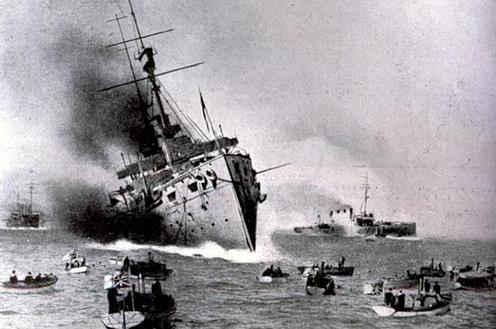 Cuban War (Instituto Nacional de Tecnologías Educativas)The liberals soon became disillusioned with the revolution and frightened by the Carlist reaction. All of these sentiments provided the ideal conditions for the Restoration of Alfonso XII.
Cuban War (Instituto Nacional de Tecnologías Educativas)The liberals soon became disillusioned with the revolution and frightened by the Carlist reaction. All of these sentiments provided the ideal conditions for the Restoration of Alfonso XII.
The Restoration: The Loss of the Last Colonies
The beginning of Alfonso XII's reign was marked by two successes: the end of the Third Carlist War and the approval of a new constitution (1876), and a certain stability based on the existence of two political formations that represented the majority of the electorate: the Conservative Party led by Cánovas, supported by the court and latifundista aristocracy, landowners and people of independent means, and Sagasta's Liberal Party, whose members included people from the professional and middle classes, as well as merchants and industrialists. Their rotation in power, especially after the death of the king and the regency of his wife Maria Christina (1885-1902), gave rise to a period of stability interrupted only in its last phase by the incidents and confrontations in Morocco and the loss in 1898 of the last two remaining colonies: Cuba and the Philippines.
The Early 20th Century
The dawn of the 20th century in Spain was marked by a series of profound unsolved problems. Some of these problems were structural; the population had almost doubled since the beginning of the previous century, rising from 11 to 18.5 million in a land of limited resources. There were also agrarian problems: latifundismo, low yields and a high percentage of land left uncultivated. In addition to these problems, capital funds and the existing infrastructure were insufficient to launch heavy industry, and consumer capacity was very low, all of which gave rise to a protectionism that was both costly and for the most part non-competitive.
At the same time, the political problems that had arisen in the previous century became more acute. In addition to the political and intellectual frustration resulting from Spain's loss of influence on the world stage, plus the disappearance of its colonial empire, the country now had to face the regionalist problem, either in the form of federalism or claims for a return to the old regime of fuerismo, the system of special privileges that had characterised the Carlists. Similarly, the cantonalism expressed during the ephemeral First Republic raised its head again. However, the main problem undoubtedly emerged from the social and trade union movements of the working class, which was destined to play a historic and decisive role throughout the 20th century.
Working class associations first emerged in Spain in 1830 and gave rise to moments of great social agitation, even including a general strike (1855). In 1868, Fanelli, a follower of Bakunin, established sections of the International Workers' Association in Spain, rapidly recruiting 100,000 members in Catalonia and Andalusia. After several periods of action and successive repressions, in 1911 the movement evolved into the CNT (Confederación Nacional del Trabajo - National Confederation of Labour), which retained the support of the Spanish working class until the end of the Civil War. The arrival in Spain of Lafargue, sent by Marx, failed to halt the development of Bakunism, as described by F. Engels in his famous collection of articles.
On 2 May 1879 the PSOE (Partido Socialista Obrero Español - Spanish Socialist Workers' Party) was formed, followed in 1888, after several conferences, by the formation of the socialist union UGT (Unión General de Trabajadores - General Workers' Union). The socialist claims found a wide support base in industrial areas: among miners in Asturias, metal workers in the Basque Country and printers in Madrid.
In Catalonia powerful regional parties emerged, such as the Regionalist League that won the elections in Barcelona in 1901. The Basque Nationalist Party (PNV) was founded in 1895. One more splinter action also took place during this period - the separation of political Spain from intellectual Spain. The confrontation between traditional ideas and progressive ideas also spread to the literary and scientific fields, where the most important intellectual movement, Krausism (based on the ideas of German philosopher Karl Christian Friedrich Krause), had a particularly strong influence on education - the freethinking Institución Libre de Enseñanza run by Giner de los Ríos - and on research - the so-called Junta para la Ampliación de Estudios (Board of Further Study) promoted and run by Cajal, Castillejo and Bolívar. Spanish intellectuals, creators of extraordinary philosophical, literary, historical and scientific schools of thought - Unamuno, Ortega, Azaña, Altamira, Sánchez Albornoz, Menéndez Pidal, Marañón, Negrín, Moles and many others - took sides and, in some cases, served as political leaders in the dilemma of 1931.
Spain and the First World War: The Authoritarianism of Primo de Rivera
In 1902, Alfonso XIII took the throne and the emergence of new political forms threw the Canovite and liberal-conservative two-party system into crisis. There were also several important expressions of social unrest, such as the Tragic Week of 1909 in Barcelona and popular resistance to the drafting of troops for the war in Morocco.
Spain's neutral position during the First World War was only a parenthesis. Price increases and the contraction of the European market generated enormous instability, leading in 1917 to the summons of the Parliamentary Assembly in Barcelona, which recommended the reform of the constitution, and a general strike in August of the same year.
Following the failure of constitutional reform, the regional problem re-emerged, this time more acutely, and there were outbreaks of social and peasant unrest in both Andalusia and Catalonia. Coinciding with all of this (1921), the PCE (Partido Comunista de España-Communist Party of Spain) was formed when the PSOE failed to join the Comintern, created as a consequence of the victory of the October Revolution in Russia.
But above all, the crisis was rooted in the Moroccan War. When Spanish troops were massacred at Annual (1921), unleashing a wave of criticism against the government and the military administration, General Primo de Rivera staged a coup d'état (13 October 1921) and installed a military government.
Described as "mild despotism", Primo de Rivera's dictatorship attempted to solve several problems by ending the Moroccan War, developing infrastructure for the country and promoting public works. Although ideologically aligned with the authoritarian regimes in Europe, it adopted a more traditional, monarchic and Catholic philosophy than the one adopted in Mussolini's new state. Its failure was mainly political, despite attempts to create a single party and involve certain sectors of the workers' movement in political life. Neither was it able to re-organise industrial relations on the basis of corporations, nor solve the agrarian and regional problems.
An attempt to reform the constitution through the creation of a consultative National Assembly in 1926 also failed to materialise, and when the financial crash of 1930 occurred, the dictator was forced to resign. He was replaced by General Berenguer.
The Collapse of the Monarchy and the Second Republic
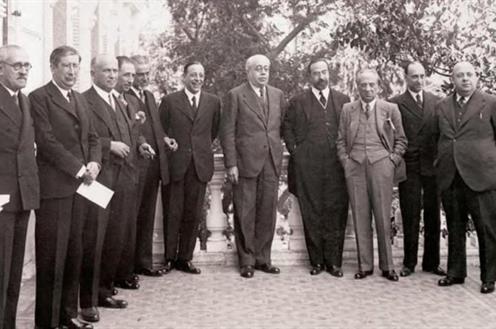 Azaña's Cabinet in 1933 (Bettman and Corbis)In August 1930, Republican, Socialist and Catalonian nationalist politicians signed the Pact of San Sebastian, and on 12 December a military uprising in favour of the republic took place in Jaca. Officers Galán and García Hernández were shot, which led to the resignation of Berenguer, and a group of intellectuals - Ortega y Gasset, Marañón, Pérez de Ayala - declared themselves to be "At the Service of the Republic".
Azaña's Cabinet in 1933 (Bettman and Corbis)In August 1930, Republican, Socialist and Catalonian nationalist politicians signed the Pact of San Sebastian, and on 12 December a military uprising in favour of the republic took place in Jaca. Officers Galán and García Hernández were shot, which led to the resignation of Berenguer, and a group of intellectuals - Ortega y Gasset, Marañón, Pérez de Ayala - declared themselves to be "At the Service of the Republic".
The last monarchic government was formed in February 1931 and immediately called municipal elections for 12 April, resulting in victory for the left and the Republicans in the main cities. On 14 April the Second Republic was proclaimed. Alfonso XIII left Spain and went into voluntary exile.
The Republicans called general elections on 28 June, announced religious freedom and drew up a new constitution, approved on 9 December. Its preamble stated, "Spain is a democratic republic of workers of all classes, organised in freedom and justice. The powers of its bodies rest with the people. The republic is a fully-integrated state, compatible with the autonomy of the municipalities and the regions." The organisation of the state was expressed as democratic, secular, decentralised, and equipped with a single representational house and a Constitutional Court.
A preoccupation with reform marked the first two years of the republic (1931-1933) under the leadership of Alcalá Zamora and Azaña, who adopted a three-pronged approach: the Basic Law of Agrarian Reform, the solution to the regional problem with statutes of autonomy for Catalonia and the Basque Country, and a particular emphasis on educational and cultural policy. However, two issues created considerable tension: religion and military policy, which the Azaña Law failed to solve and only aggravated even further. Evidence of this was provided by General Sanjurjo's abortive coup on 10 August 1932. The following year began with the repression of the uprising at Casas Viejas and municipal elections that showed a clear swing to the right. This trend was represented by the CEDA (Confederación Española de Derechas Autónomas - Spanish Confederation of Autonomous Right-Wing Parties) (Gil Robles); Renovación Española (Spanish Revival) (Calvo Sotelo) and Comunión Tradicionalista (Traditional Communion). On 29 October, José Antonio Primo de Rivera founded the Falange Española, or Spanish Falangist Movement.
New general elections on 19 November gave a clear victory to the right and the administration led by Lerroux and CEDA was formed. The new government revoked several laws, including the Agrarian Reform, and issued an amnesty for the rebel troops involved in the abortive coup of 1932. Following Lerroux's resignation, the Cortes were dissolved and the elections of 16 February 1936 were won by the Popular Front, a coalition group uniting Azaña's Republican Left, Esquerra Catalana led by Companys (Catalonian Left), Largo Cabellero's Socialist Party, Martínez Barrio's Republican Union and the Communist Party. The initial government led by Azaña announced a general amnesty and reinstated the agrarian reform and the statutes of autonomy for Catalonia and the Basque Country, and later Galicia. In May, Azaña was elected President of the Republic and Casares Quiroga set up a new administration. On 17 July, the military forces at the Melilla garrison staged an uprising, marking the outbreak of the Spanish Civil War.
The Military Uprising and the Outbreak of the Civil War
On 18 July the military coup spread and the following day Francisco Franco took command of the army in Morocco. By the end of 1936, the Nationalist troops had seized most of Andalusia, Extremadura, Toledo, Ávila, Segovia, Valladolid, Burgos, Leon, Galicia, part of Asturias, Vitoria, San Sebastian, Navarre and Aragon, as well as the Canary and Balearic Islands, except for the island of Minorca. Madrid, New Castile, Catalonia, Valencia, Murcia and Almeria, Gijón and Bilbao became Republican bastions.
The Republican government formed a coalition cabinet led by Giralt, succeeded in his post by Largo Caballero, who brought in representatives of the CNT and moved the cabinet to Valencia. On 29 September the National Defence Committee appointed General Franco head of the government and commander-in chief of the army. The Republican government reacted to this by creating the Popular Army and reorganising the militias into professional armies. Help from abroad also arrived for both bands - the International Brigades to support the Republicans, and Italian and German troops to provide assistance to the Francoist troops.
The year 1937 was characterised by an intensification of the war in the north. The Republicans reacted by establishing fronts in Guadalajara (March), Brunete (July) and Belchite (August). The year closed with the beginning of the Battle of Teruel. At that time, the Francoist troops concentrated their efforts in Aragon, winning back Teruel and, after their triumphal entry in Castellón in June 1938, dividing the Republican zone in two. The government response was the so-called Battle of the Ebro (July-November 1938), which ended with a Republican defeat and 70,000 lives lost.
Having lost their final stronghold, the Republicans began to seek exile in France and on 10 February 1939 the Francoist troops claimed control of Catalonia. Only Madrid still held out, and when the peace proposals of its Defence Committee (Casado, Besteiro) failed, the Francoist troops occupied the capital on 28 March 1939. A fi nal war dispatch by General Franco on 1 April announced the end of the conflict.
Franco's Dictatorship
The new regime was characterised by three factors: repression of the defeated band, economic hardship, and a modification of the internal balance of power as the result of changes on the international stage brought about by World War II. Despite an initial declaration of its neutrality and then its "non-belligerence", the new government became isolated from the outside world. Franco met with Hitler and Mussolini, thereafter entrusting foreign policy to the Germanophile Serrano Suñer.
Although diplomacy under France played the anti-communist card, it could not avoid condemnation from the United Nations, the withdrawal of ambassadors and the closure of the French border.
In economic terms, international isolation and, to a lesser degree, ideological differences generated an autocratic and corporatist approach, which more or less accompanied the regime throughout its history. In agricultural terms, the country experienced a dramatic regression in relation to previous periods, giving rise to a shortage of basic supplies and the introduction of rationing.
The Cold War and Economic Development
The beginning of the Cold War provided a boost for Franco's regime, although Spain was excluded from the reconstruction of Europe. In 1953, the Holy See signed a concordat with Spain and the United States signed a treaty of reciprocal aid in military matters.
Meanwhile, in the political arena, the UN accepted the renewal of diplomatic relations in 1950, and in 1955 Spain occupied its seat in the international forum. A year later the Spanish protectorate was abolished in Morocco, which declared independence.
Social unrest had emerged, albeit timidly, in the 1951 labour strike in Barcelona and later with the first student riots in 1956. Extraordinarily high inflation led to the introduction of a Stabilisation Plan (1959) to offset the lack of currency. Although the effect of this was economic stagnation and new outbreaks of social unrest in Asturias, it did pave the way for the First Development Plan (1963), which was merely orientational for the private sector but binding for the public sector. In order to promote regional and local development, the socalled "development poles" - areas zoned for economic activities - were created.
Drawn up according to guidelines issued by the International Monetary Fund and the European Organisation for Economic Cooperation, the Stabilisation Plan boosted the economy and laid the foundations for an autocratic model of development. In accordance with these guidelines, in 1967 the Spanish peseta was devalued and in 1968 the Second Development Plan, similar in scope to the first one, was launched. By this time the population of Spain had reached 33 million, of which 12 million (38.3%) represented the working population, virtually distributed into three equal parts as follows: agriculture (28%), industry (38%) and services (34%). Thousands of people emigrated from the impoverished rural areas to the industrial cities (Madrid, Bilbao, Barcelona), while thousands of others departed for Europe in search of better opportunities. The funds these workers sent back to their families in Spain constituted a crucial contribution to the country's balance of payments.
Politically, the regime attempted to organise a so-called "organic democracy" with a referendum to approve the Organic Law of the State (1966). Two years later Guinea gained independence, followed in the same year by the declaration of a state of emergency in the northern province of Guipúzcoa.
The Twilight of the Dictatorship
The economic changes that concluded a long process of development also produced social changes. The politicians who had emerged in the Civil War - military groups, Falangists, traditionalists, Catholic- Nationalists - were replaced by technocrats, mainly senior civil servants, who advocated the need for economic progress and forward-looking policies.
This led to a period of goodwill and renewed relations with countries of the East and the signature in 1970 of a preferential trade agreement between Spain and the European Common Market. A year earlier, on 22 July 1969, Parliament had appointed Don Juan Carlos de Borbón as Franco's successor as head of state, with the title of king.
Since the early 1960s, opposition to Franco's regime had become stronger as a result of the profound social changes produced by economic alterations in the country. In addition to the participation of exiled politicians and institutions in international forums, internal opposition movements had also gradually taken shape. Students, teachers and intellectuals represented a democratic left-wing front, while the working class focused their struggles through the trade unions and a civil front. These movements were the origin of the political forces that later played a leading role in Spain's transition to democracy.
In the political sphere, the monarchy - embodied in the person of the Count of Barcelona, Juan de Borbón - proposed the need for a return to democracy. An extremely active PCE (Spanish Communist Party) had launched its policy of national reconciliation and proposed overcoming the regime by peaceful means. The socialists and Christian democrats also called for a return to democracy as the only viable means of integration with Europe.
The Church's isolation was increasingly apparent. Rank-and-file priests, especially in Catalonia, the Basque Country and Madrid, were openly critical of the regime, and were joined in their condemnations by several prelates. Meanwhile, these stances coincided with the radicalisation of nationalist positions and the emergence of ETA's terrorist activity.
A series of political trials were held. In 1969, a group of Basque priests were tried by court-martial, and in 1970 the "Burgos Trial" was held and nine death sentences were passed down, although the condemned men were later pardoned.
At the end of 1969 a new cabinet with a technocrat majority was formed, which was subsequently replaced in 1973 by a cabinet with similar leanings. The latter proved to be short-lived; in December, the cabinet president Carrero Blanco was killed in a terrorist attack by ETA. Arias Navarro was then appointed president and formed what was to be the last cabinet under Franco's regime.
In July 1974 Franco was afflicted with thrombophlebitis. Prince Juan Carlos took over as provisional head of state on 30 October 1975, and on 20 November Franco died. On 22 November, Juan Carlos I was crowned King of Spain. Another chapter in Spain's history closed and the doors of freedom and hope opened for all Spaniards.
Democracy
The Transition from Dictatorship to Democracy
From the outset, the new monarch adopted a determined but prudent attitude to ensure the rapid democratisation of Spain, turning the institution he embodied into a "monarchy of all Spaniards". However, this was no easy task. He was obligated to "respect" the legal structure inherited from Franco's regime, as well as most of the existing political frameworks.
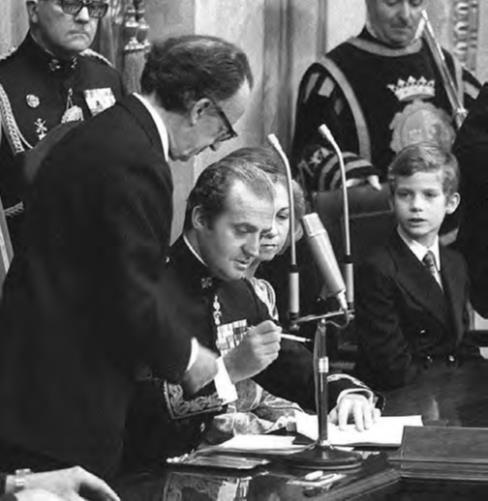 H. M. the King sanctioning the Spanish Constitution (Manuel H. de León, Efe)Following the resignation of Arias Navarro, the king entrusted the leadership of the country to a group of young reformists headed by Adolfo Suárez, who was sworn in as president of Spain on 3 July 1976. Under the watchful eye of the king, it was up to him to achieve the transition from dictatorship to democracy. Numerous left-wing politicians and intellectuals - Madariaga, Sánchez Albornoz, Pasionaria, Sénder, Guillén and Llopis - returned from exile and on 15 June 1977, in a context of total freedom and open democracy, the first general elections were held. The Spanish right did not hesitate to accept the democratic rules of play under the leadership of Manuel Fraga, a former minister under Franco and the founder of Alianza Popular (Popular Alliance). The Communist Party of Spain, headed by a former leader of Republican Spain who had been exiled for years (Santiago Carrillo), participated in the drafting of the constitution and also embraced the role of the democratic institutions. However, the electorate - to the surprise of many - voted for more moderate options than these two formations and the day was won by the UCD (Unión de Centro Democrático), the centrist party founded by Suárez to support the transition. With a relative majority, this party obtained 165 seats, followed by 118 seats for the PSOE (the historic Socialist Party, in which a young generation led by Felipe González had just replaced the old guard of exiles who still clung to the memory of the Civil War). The Catalans and Basques were represented by a variety of parties.
H. M. the King sanctioning the Spanish Constitution (Manuel H. de León, Efe)Following the resignation of Arias Navarro, the king entrusted the leadership of the country to a group of young reformists headed by Adolfo Suárez, who was sworn in as president of Spain on 3 July 1976. Under the watchful eye of the king, it was up to him to achieve the transition from dictatorship to democracy. Numerous left-wing politicians and intellectuals - Madariaga, Sánchez Albornoz, Pasionaria, Sénder, Guillén and Llopis - returned from exile and on 15 June 1977, in a context of total freedom and open democracy, the first general elections were held. The Spanish right did not hesitate to accept the democratic rules of play under the leadership of Manuel Fraga, a former minister under Franco and the founder of Alianza Popular (Popular Alliance). The Communist Party of Spain, headed by a former leader of Republican Spain who had been exiled for years (Santiago Carrillo), participated in the drafting of the constitution and also embraced the role of the democratic institutions. However, the electorate - to the surprise of many - voted for more moderate options than these two formations and the day was won by the UCD (Unión de Centro Democrático), the centrist party founded by Suárez to support the transition. With a relative majority, this party obtained 165 seats, followed by 118 seats for the PSOE (the historic Socialist Party, in which a young generation led by Felipe González had just replaced the old guard of exiles who still clung to the memory of the Civil War). The Catalans and Basques were represented by a variety of parties.
Support from the press for the transition to democracy was crucial. So too was the prudence exercised by all the political and trade union groups, who at the end of October of the same year signed the Moncloa Pacts to consolidate democracy and provide a boost to the economy, which was already threatened by the first signs of recession.
The transition, in which Adolfo Suárez played a central role, transformed Spain into a modern country in all respects: freedoms of all types were guaranteed and a multiparty parliamentary system was established; the social function of political parties and trade unions was recognised; and the state adopted a decentralised form of government, paving the way for the formation of autonomous regions throughout the country. These changes were backed by a widespread consensus, demonstrating the degree to which the Spanish had overcome the wounds of the Civil War and were capable of looking towards the future rather than remaining mired in the past. Without a doubt, this is the most important legacy of the transition initiated in 1977. Spain had already had a number of constitutions, a long history of parliamentary life and even the experience of a former democracy, but this was the first time that changes were introduced of common accord. Dialogue and negotiations formed the basis for establishing the widest possible social consensus. This climate of consensus and the peaceful nature of the transition to democracy attracted the interest of politicians and analysts in numerous countries, especially the citizens of Latin America and the former Soviet bloc nations of Eastern Europe searching for the best way to achieve their own transitions from dictatorship to freedom.
The reign of Don Juan Carlos, who has been on the throne for more than thirty years now, received widespread popular support from the outset, and this has increased over the years thanks to the king's discretion in the exercise of his constitutional duties.
The transition brought about a genuine national reconciliation, demanding sacrifices in every quarter. Conceived as a legal evolution from the existing institutions, it was incompatible with the demand for punishing those who had supported the dictatorship. On the contrary, its premises were to offer a generous amnesty and to strive for total democracy. The process of consensus that had been undertaken, in which all the political parties had to make sacrifices (for example, the Socialists and Communists abandoned their dream of a republic), permitted the introduction of a provisional package of self-government measures in Catalonia and the Basque Country and the drafting of the constitution, which was approved by a vast majority (87.87%) on 6 December 1978.
Spain after the Constitution of 1978
New general elections held on 1 March 1979 maitained the national balance of power (UCD, 34.3%; PSOE, 30%; PCE, 10.6%). However, the first municipal elections (19 April) gave left-wing coalitions 77% of local councils in the main cities, marking the beginning of the end for the UCD.
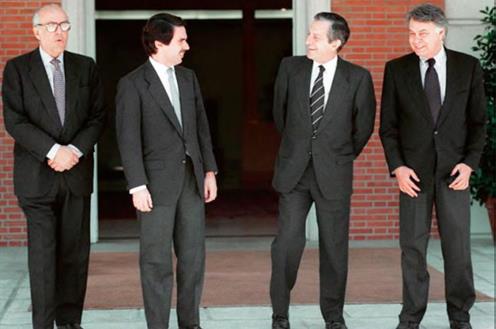 The first four presidents of democratic Spain (J. M. Espinosa, Efe)The weakening of this party and the change of president coincided with a final authoritarian attempt to overthrow democracy. On 23 February 1981, members of the Civil Guard burst into Congress and held the representatives hostage, while one of the military headquarters ordered its troops to take the streets. The decisive intervention of the king foiled the attempted coup and the Spanish people took to the streets in defence of democracy. However, the incident served to weaken both the administration and the party it represented even further.
The first four presidents of democratic Spain (J. M. Espinosa, Efe)The weakening of this party and the change of president coincided with a final authoritarian attempt to overthrow democracy. On 23 February 1981, members of the Civil Guard burst into Congress and held the representatives hostage, while one of the military headquarters ordered its troops to take the streets. The decisive intervention of the king foiled the attempted coup and the Spanish people took to the streets in defence of democracy. However, the incident served to weaken both the administration and the party it represented even further.
On the stage of international politics, Spain's incorporation into the group of democratic countries was complete. The country applied for membership in the EEC on 28 July 1977 and on 1 January 1986, Spain became a member state. Leopoldo Calvo
Sotelo, Suárez's successor as president, proposed and gained approval from Congress for membership in NATO (29 October 1981), which was later ratified in a popular referendum held in 1986.
On 28 October 1982, new general elections were held in which the PSOE obtained an absolute majority (202 seats) and 106 seats were given to a new right-wing alliance of the AP-PDP (Alianza Popular-Partido Demócrata Popular - Popular Alliance-Popular Democratic Party). The elections had two major losers: the UCD, which scraped by with only 7.2% of the votes, and the PCE with 3.8%.
On 3 December, Felipe González constituted his first administration. The PSOE managed to retain its majority in the following two elections, held on 22 June 1985 and 29 October 1989.
By then, the party had become a moderate and reformist party of social democrats, abandoning its traditional Marxist ideology. Backed by successive electoral victories, it governed until 1996 and carried out a sweeping modernisation of the country.
Thanks to this period of remarkable political stability, it was possible to make up for lost time in fields such as education, health and taxation, while the army was made professional, industry was streamlined, public infrastructures were built, social services were extended, etc. Moreover, in 1992 this modern, dynamic Spain, capable of joining the European Union (1986) and exercising its periodic presidencies of the Union (1989, 1995 and 2002) with efficiency and creativity, presented a new image to the world with the organisation of the World Fair in Seville, the European Cultural Capital in Madrid and the Olympic Games in Barcelona. With the former isolation of the dictatorship relegated to the past, Spain returned to the international arena as an agent of peace and harmony, promoting Latin American Summits (since 1991), participating in the United Nations' peace-keeping forces in Africa, the Balkans, Middle East and Central America, hosting conversations between Israel and the Arabic nations (Madrid Conference, 1991), dramatically increasing its aid to developing countries (through the Spanish Cooperation Agency), exporting the activities of its technicians and business leaders to distant markets (with strong investment in Latin America), reinforcing the presence of the Spanish language and culture around the world (through the Cervantes Institute, created in 1991).
Although in the elections of 6 June 1993 the PSOE still managed to obtain the most votes (159 seats), enabling Felipe González to form a non-coalition government (inaugurated on 8-9 July 1993), the loss of the absolute majority forced the party to turn to other parliamentary groups in order to gain sufficient support in the Congress and Senate to ensure the stability of the government. In the end this was made possible by agreements reached with the CiU (Convergencia i Unió - Convergence and Union).
Meanwhile the Partido Popular had been restructured and renamed in 1989 around the new leadership of José María Aznar and an ethos based on liberal ideals and Christian democracy, oriented towards the reformist centre. Its favourable results at the municipal, regional and European elections in 1995 culminated in victory at the general elections in 1996, which with support from the moderate nationalist groups of Catalonia (Convergencia i Uniò), the Basque Country (PNV) and the Canary Islands (Coalición Canaria - Canary Coalition) placed the presidency in Aznar's hands.
The Partido Popular was again victorious in the general elections of 2000, obtaining a comfortable absolute majority. The economic policy pursued by this administration focused on controlling inflation and the public deficit as a means of reactivating economic growth. The successes achieved in the economic arena were crowned by Spain's admission to the first group of countries to adopt the single European currency - the euro - in 2002, after the Spanish economy had successfully met all the necessary requirements.
Spain's presidency of the European Union in the first half of 2002 coincided with the introduction of the euro, thereby completing a significant cycle in the recent history of the country; coincidentally, the euro was adopted as the name of the single currency at the Council of Europe held in the second half of 1995, when Spain also happened to be holding the presidency of the Union.
On Thursday, 11 March 2004, Spain was dealt a dramatic blow by a kind of terrorism that bore little resemblance to that of the terrorist organization ETA. A group of radical Islamist extremists killed 192 people and wounded almost 2,000 more in Madrid, in the worst terrorist attack perpetrated in Europe to date. Three days later, the people of Spain turned out to cast their votes in the general elections as planned.
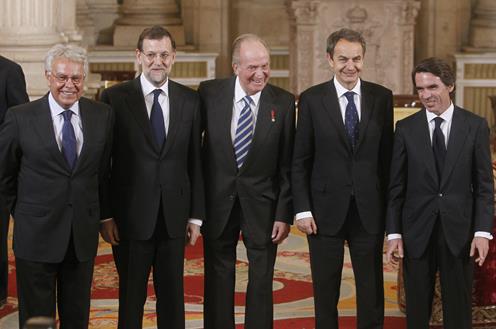 H. M. the King with the current president of the Government and his predecessors (Efe)On 14 March 2004, the PSOE won the general elections, making José Luis Rodríguez Zapatero the fifth president to take power in democratic Spain (164 seats). This led to the formation of Spain's first ever gender-balanced government. The measures adopted by this government included the withdrawal of Spanish troops from Iraq, the Common Law on Domestic Violence, the Common Law on Equality, the Common Law on Historic Memory, the Common Law on Dependence and that legalizing same-sex marriage. Zapatero also proposed the international Alliance of Civilizations initiative, which was adopted as an official programme of the United Nations in April 2007.
H. M. the King with the current president of the Government and his predecessors (Efe)On 14 March 2004, the PSOE won the general elections, making José Luis Rodríguez Zapatero the fifth president to take power in democratic Spain (164 seats). This led to the formation of Spain's first ever gender-balanced government. The measures adopted by this government included the withdrawal of Spanish troops from Iraq, the Common Law on Domestic Violence, the Common Law on Equality, the Common Law on Historic Memory, the Common Law on Dependence and that legalizing same-sex marriage. Zapatero also proposed the international Alliance of Civilizations initiative, which was adopted as an official programme of the United Nations in April 2007.
On 9 March 2008, the Partido Socialista Obrero Español again won the general elections with 169 seats.
This signalled the second term of office for José Luis Rodríguez Zapatero, which was marked by the international and domestic economic crisis. During this period, a new regional funding agreement was concluded, which was approved by the Fiscal and Financial Policy Council that represents all of the autonomous communities. It was also agreed to remove advertising from Radio Televisión Española (RTVE) to strengthen its role as a public service. The Common Law on Sustainable Economy was also adopted during this period, which sought to establish the bases for boosting Spain's production model in what has been the toughest international economic crisis of in recent years.
For the purpose of building certainty in the political forces and institutions in this difficult economic context, the next general elections were called four months ahead of the deadline marking the end of the legislature, on 20 November 2011. This time, the Partido Popular obtained the most votes, with an absolute majority (186 seats). The new government, led by Mariano Rajoy, marked out an ambitious programme to address the economic crisis and achieve recovery. It includes the adoption of various initiatives and measures with two complementary aims: budgetary stability by reducing the deficit and practising austerity in public spending, and boosting economic growth and job creation through structural reform.
Timeline
Prehistory
- 1,500,000 B. C. First human findings on the Iberian Peninsula
- 40,000-15,000 B. C. Altamira cave paintings
Spain before the Romans
- 1,200-800 B. C. Indo-Europeans, Phoenicians and Greeks invade the Iberian Peninsula
- 800-500 B. C. Tartessus
Roman Hispania (218 B. C.-409 A.D.)
The Visigothic Kingdom (472-710)
Moorish Spain (710-1492)
- 756-929 Umayyad emirate
- 929-1031 Caliphate
- 1031-1090 Taifa kingdoms
- 1090-1146 Almoravid invasion
- 1146-1224 Almohad invasion
- 1224-1232 Marinid invasion
- 1232-1492 Nasrid kingdom of Granada
Christian Spain (710-1492)
- 803 Kingdom of Navarre
- 1137 Crown of Aragón
- 1230 Kingdom of Castile and Leon
- 1479 Union of the Crowns of Castile and Aragón with the Catholic Monarchs
- 1492 Conquest of Granada, Columbus' discovery of America and the publication of the first Spanish grammar text (Gramática Castellana)
- 1512 Incorporation of Navarre
- 1535-1545 Viceroyalties of Mexico and Peru
House of Habsburg (1516-1700)
- 1516-1556 Charles I
- 1526 Treaty of Madrid
- 1556 Philip II
- 1571 Battle of Lepanto
- 1598-1621 Philip III
- 1605 Don Quixote.
- 1621-1665 Philip IV
- 1640 Secession of Portugal
- 1659 Treaty of the Pyrenees
- 1665-1700 Charles II
House of Bourbon (1700-1808)
- 1700-1746 Philip V
- 1713 Treaty of Utrecht
- 1746-1759 Ferdinand VI
- 1759-1788 Charles III
- 1760-1790 Enlightenment and reform
- 1788-1808 Charles IV
- 1805 Battle of Trafalgar
- 1807 Treaty of Fontainebleau
Dissolution of the Old Regime and the Peninsular War (1808- 1814)
- 1808 Abdication of Charles IV and Ferdinand VII in Bayonne. Entry of Joseph Bonaparte I in Madrid.
- 1810-1812 The Cortes and Constitution of Cádiz
Liberal reaction and Revolution (1814-1833)
- 1814 Arrival of Ferdinand VII in Madrid
- 1814-1820 First Absolutist Restoration
- 1820-1823 The Uprising and Liberal Triennium
- 1823-1833 Second Absolutist Restoration
Regency periods (1833-1843)
- 1833-1841 Death of Ferdinand VIl and Regency of Maria Christina Carlist War
- 1834 Royal Statute
- 1837 Liberal Constitution
- 1841-1843 Regency of Espartero
Reign of Isabella II (1843-1868)
- 1843-1854 Moderate Decade
- 1845 Constitution
- 1854-1856 Liberal Biennium
- 1856 "Non nata" constitution
- 1856-1868 Moderate Predominance
Revolutionary Six Years (1868- 1874)
- 1869 Constitution of 1869
- 1869-1871 Regency of General Serrano
- 1871-1873 Reign of Amadeus of Savoy
- 1873-1874 First Spanish Republic
- 1874 Coup staged by Martínez Campos on behalf of Alfonso XII.
Restoration (1875-1923)
- 1875 Entry of Alfonso XII in Madrid
- 1876 Constitution
- 1881 Liberal government
- 1885 Death of Alfonso XII Regency of Maria Christina
- 1890 Universal suffrage
- 1898 Spanish-American War and Treaty of Paris
- 1902-1931 Reign of Alfonso XIII
Dictatorship of Primo de Rivera and the fall of the Monarchy (1923-1931)
- 1931 Municipal elections (14 April) and Proclamation of the Second Spanish Republic
Second Republic and Spanish Civil War (1931-1939)
- 1931 Republican Constitution
- 1933 Electoral victory of CEDA
- 1936 Electoral victory of the Popular Front (February) and military coup (July)
- Civil War (1936-1939)
General Franco's regime (1939-1975)
- 1959 Stabilization Plan
- 1969 Appointment of Prince Juan Carlos as successor
Democratic transition
- 1975 Death of Franco Proclamation of King Juan Carlos I
- 1976 Common Law on Political Reform (November) and Referendum (December)
- 1977 General elections (15 June) Relative majority for the UCD President Adolfo Suárez (4 July) Spain requests membership in the EEC (28 July)
- 1978 Constitutional referendum (6 December) Constitution sanctioned by H.M. the King on 27 December in Parliament Enters into force on 28 December
Constitutional Monarchy
- 1979 General elections (1 March).
- 1979 Congress approves Spain's accession to NATO (29 October)
- 1982 General elections. Absolute majority for the PSOE (28 October). New government with Felipe González as president (3 December)
- 1985 Signature of Spain's treaty of adhesion to the EEC (12 June)
- 1986 Spain and Portugal become full EEC members (1 January). Prince Felipe swears allegiance to the Constitution in Parliament (30 January). Positive results in the referendum on Spain remaining in NATO (12 March). General elections. New absolute majority for the PSOE (22 June)
- 1989 Spanish presidency of the EC (first half). European elections (15 June). General elections. Victory for the PSOE (29 October). Felipe González takes the presidential oath of office before Parliament (5 December)
- 1993 General elections (6 June). Relative majority for the PSOE. Felipe González takes the presidential oath of office before Parliament (9 July)
- 1995 Spanish presidency of the European Union (second half). The European Council of Madrid approves the name of the future European currency: the euro (15-16 December)
- 1996 General elections (relative majority for the PP). José María Aznar is sworn in as president before Parliament (3 May)
- 2000 General elections (victory with an absolute majority for the PP). José María Aznar takes the presidential oath of office before Parliament (25 April)
- 2002 Spanish presidency of the European Union (first half)
- 2004 General elections (victory for the PSOE with a relative majority). José Luis Rodríguez Zapatero takes the presidential oath of office before Parliament (17 April). European elections (13 June)
- 2005 European Constitution Referendum (20 February)
- 2008 General elections (victory for the PSOE with a relative majority). José Luis Rodríguez Zapatero takes the presidential oath of office before Parliament (8 April)
- 2010 Spanish presidency of the European Union (first half)
- 2011 General elections (20 November). Victory for the PP with an absolute majority. Mariano Rajoy takes the presidential oath of office before Parliament (20 December)





